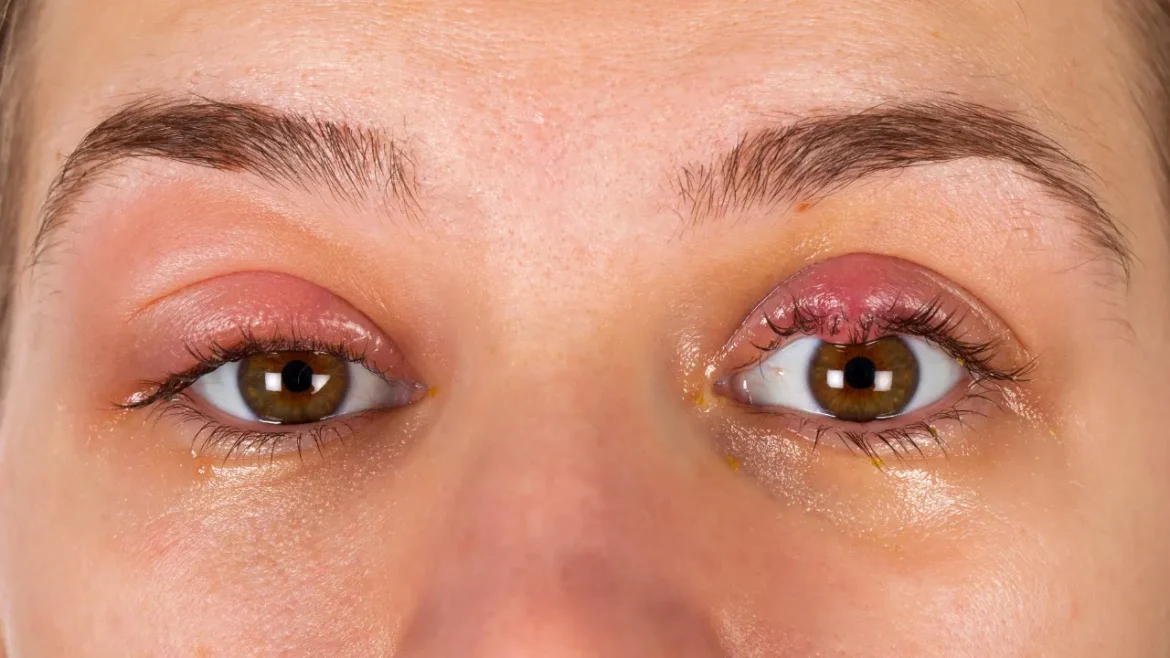Description
Sebaceous glands are in charge of creating and secreting sebum, a greasy material that lubricates our skin and hair. Sebaceous carcinoma represents a malignant tumor that develops from these glands. Although it typically affects the eyelids, this uncommon type of skin cancer can also affect the neck, head, and genital areas of the body because they contain sebaceous glands. A nodule or tumor on the region being impacted that is painless and slowly expanding is the first sign of sebaceous carcinoma. Its vague look makes it susceptible to being confused with other benign illnesses. The tumor frequently has a solid, yellowish appearance and can exhibit crusting or ulceration on the surface.
You May Also Like:
IS DR MERCOLA KRILL OIL TRULY A GREAT SOURCE OF DAILY OMEGA-3S?
IMPORTANT INFORMATION ABOUT BULLETPROOF KRILL OIL: A LEADING OMEGA 3 PRODUCT
Sebaceous Carcinoma: Description, Causes, And Treatment Protocol is an original (HealthXWire) article.
Possible Causes
The specific reasons for the cause of this illness remain unclear. However, numerous variables have been found that could influence its growth. These potential causes include:
Radiation Exposure: Sebaceous carcinoma is potentially predisposed by prior ionizing radiation exposure, whether for occupational or medical reasons like radiation therapy for various cancers or exposure to elevated radiation levels.
Genetic Predisposition: Certain individuals can be more likely to develop sebaceous carcinoma due to inherited genetic alterations. An example of a genetic illness with internal malignancies and sebaceous tumors is Muir-Torre syndrome.
Chronic Inflammation: Sebaceous gland inflammation that has persisted for a long time, possibly brought on by disorders like chronic blepharitis, i.e., inflammation along the eyelid edges, or chronic acne, is a potential contributing factor for the emergence of sebaceous cancer. The likelihood of cellular processes becoming abnormally malignant is increased by inflammation.
Immunodeficiency Disorders: Sebaceous carcinoma is more likely to develop among people with weakened immune systems, including people with HIV/AIDS or if they are receiving immunosuppressive treatment following organ donation. Tumor development can be made possible by the immune system’s weaker reaction.
Other Factors: Other, less well-known causes of sebaceous carcinoma have been discovered, including exposure to specific toxins or chemicals, viral infections like the Epstein-Barr virus or human papillomavirus, alongside hormonal abnormalities.

Exacerbating and Mitigating Factors
Immunodeficiency Disorders: Sebaceous carcinoma risks may be increased in people with compromised immune systems, including those who are suffering from HIV/AIDS or receiving immunosuppressive medication.
Radiation Exposure: Prior radiation exposure from medical procedures or work-related dangers can be a significant factor.
Genetic Predisposition: The likelihood of getting sebaceous carcinoma can rise in the presence of specific genetic abnormalities or inherited diseases like Muir-Torre syndrome.
Chronic Inflammation: Sebaceous gland irritation that lasts for a long time, maybe brought on by ailments like chronic blepharitis or acne, and can make sebaceous carcinoma more likely to form.
Sebaceous carcinoma mitigating factors include:
Regular Skin Examinations: Self-examinations can help with early detection and timely treatment. Suspicious skin lesions should be reported to a doctor.
Sun Protection: Sebaceous carcinoma can be prevented by minimizing sun exposure and by using sun protection techniques like wearing protective clothing, applying sunscreen, and avoiding peak sun hours.
Overall Health Management: Sebaceous carcinoma chances or severity can be potentially decreased by leading a healthy lifestyle, successfully managing chronic illnesses, and receiving proper medical therapy for immunodeficiency diseases or other underlying medical conditions.
Family History Evaluation: If you have a family history of sebaceous carcinoma and other associated illnesses, you should let your doctor know since it can necessitate more thorough monitoring and treatment.


Standard Treatment Protocol
The interdisciplinary strategy used to treat sebaceous carcinoma can differ based on the stage it is in, its location, and your personal unique characteristics of your body. The following are possible components of the typical treatment plan for sebaceous carcinoma:
Surgical Excision: The surgical excision of the tumor is the main method of therapy for sebaceous carcinoma. To ensure the total elimination of cancer cells, clean margins are the desired outcome. The dimension, location, and the involvement of any neighboring tissues in the tumor determine the scope of the surgery. To enhance tumor clearance while conserving good tissue, Mohs micrographic surgery can be used. This procedure includes carefully removing the tumor layer after layer.
Adjuvant Therapies: To treat metastatic illness or lower the possibility of recurrence, adjuvant therapies, including chemotherapy or radiation therapy, might be advised in some circumstances. In radiation therapy, cancer cells are targeted and destroyed by using high-energy beams. Chemotherapy involves medications that target cancer cells that divide quickly to stop the development and spread. Adjuvant therapy may or may not be used depending on the tumor’s features, including dimension, lymph node involvement, and depth of invasion.
Neck Dissection: Neck dissection can be done to remove the afflicted lymph nodes and stop further spread when sebaceous carcinoma has reached the lymph nodes.
Orbital Exenteration: Orbital exenteration might be required when sebaceous carcinoma has spread to the eye socket and affected the eyelids. To completely remove the tumor, the entire eye, its surrounding tissues, and occasionally even portions of the skull, are surgically removed.
Ongoing Surveillance: To check for relapse or the emergence of new lesions following therapy, regular follow-up appointments, and monitering it frequently are necessary. Physical inspections, imaging analyses, and sporadic biopsies may also be required for this.


Treatment Options
Depending on the specifics of each case and the traits of the tumor, additional treatment options beyond the usual procedure may be taken into account for sebaceous carcinoma. Among them are:
Targeted Therapies: Drugs that selectively target certain molecular defects or pathways for cancer cells are used in targeted therapy. However, currently there is a limited amount of knowledge on the topic. In September 2021, targeted therapy for sebaceous carcinoma was not well-established, and additional study is required to examine their effectiveness.
Immunotherapy: Drugs that boost the immune system’s ability to detect and eliminate cancer cells are used in immunotherapy. Although this method of treatment has produced encouraging results in many cancer types, its efficacy in sebaceous carcinoma remains to be further researched.
Clinical Trials: Sebaceous carcinoma patients may have the choice to take part in clinical studies. To enhance outcomes and broaden treatment options, clinical trials examine new therapeutic approaches, cutting-edge medications, or combinations of already-proven therapy.
Nutritional Supplements: It is significant to highlight that there is little scientific data focusing on dietary supplements, particularly for the treatment of sebaceous carcinoma. Certain dietary supplements, nevertheless, can possess potential anti-cancer effects or provide supportive advantages. Before contemplating taking any supplements, it is important to speak with your medical expert because they may offer advice based on your unique situations and possible interactions with other medications. These dietary supplements have been researched for their potential to help in managing cancer:
- Antioxidants
Antioxidants, including vitamins E and C, coenzyme Q10, and selenium have been found to shield cells from harm brought on by free radicals.
- Vitamin D
An increased risk of several malignancies has been linked to inadequate vitamin D levels. According to research, vitamin D can help control cell development and boost immune system performance.
- Omega-3 Fatty Acids
Researchers have looked into the possible anti-cancer properties of omega-3 fatty acids, which are frequently present in flaxseed, walnuts, and fatty fish. They have anti-inflammatory properties and might aid in controlling cell division and apoptosis.
- Probiotics
Healthy gut microbiota is maintained by probiotics, which are good bacteria. According to some research, probiotics can help the immune system work properly and reduce inflammation, which may have an effect on the onset and spread of cancer.
Natural and Herbal Remedies: Certain herbal and natural treatments could be supportive or might possess anti-cancer potential. The following natural and herbal therapies have been researched:
- Aloe Vera
The soothing and moisturizing properties of aloe vera, a succulent plant, are well-known. It can lessen skin irritability and speed up wound healing.
- Topical Comfrey
An herb known as comfrey or Symphytum officinale may be able to help heal wounds. Ointments or lotions containing comfrey can aid in promoting skin healing and reducing inflammation when applied topically.
- Curcumin
Turmeric contains a substance called curcumin, which has been shown in preclinical research to have anti-cancer potential. It demonstrates anti-inflammatory, anti-tumor, and antioxidant properties. It has been demonstrated that curcumin blocks a number of signaling pathways that regulate the growth of cancer cells, induce apoptosis, and inhibit the growth of cancer cells.
- Calendula
An herb frequently used in topical treatments is calendula or calendula officinalis. It may be able to relieve skin irritation thanks to its wound-healing and anti-inflammatory properties .
- Essiac Tea
Essiac tea represents an herbal blend made up of Indian rhubarb, slippery elm, sheep sorrel, and burdock root. It has been marketed as an age-old natural treatment for cancer.
- Other Herbal Remedies
The possible anti-cancer properties of several different herbs alongside plant extracts have generally been researched. A few examples are grape resveratrol, ginger, and garlic.


Conclusion
It is crucial to stress on the fact that conventional medical therapies for sebaceous carcinoma should not be replaced by natural or herbal solutions. To ensure safety, and proper use, and to prevent any possible interactions with conventional medicines, they must be utilized as adjunct treatments and reviewed with your healthcare specialists.
Additional resources for further reference
https://www.cancerresearchuk.org/about-cancer/skin-cancer/types/sebaceous-gland-carcinoma
https://dermnetnz.org/topics/sebaceous-carcinoma
https://my.clevelandclinic.org/health/diseases/24087-sebaceous-carcinoma
Important Note: The information contained in this article is for general informational purposes only, and should not be construed as health or medical advice, nor is it intended to diagnose, prevent, treat, or cure any disease or health condition. Before embarking on any diet, fitness regimen, or program of nutritional supplementation, it is advisable to consult your healthcare professional in order to determine its safety and probable efficacy in terms of your individual state of health.
Regarding Nutritional Supplements Or Other Non-Prescription Health Products: If any nutritional supplements or other non-prescription health products are mentioned in the foregoing article, any claims or statements made about them have not been evaluated by the U.S. Food and Drug Administration, and such nutritional supplements or other health products are not intended to diagnose, treat, cure, or prevent any disease.
Table of Contents


